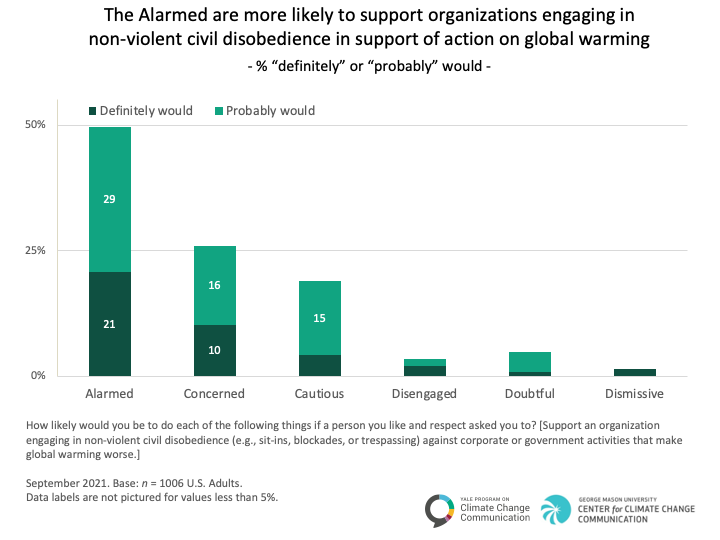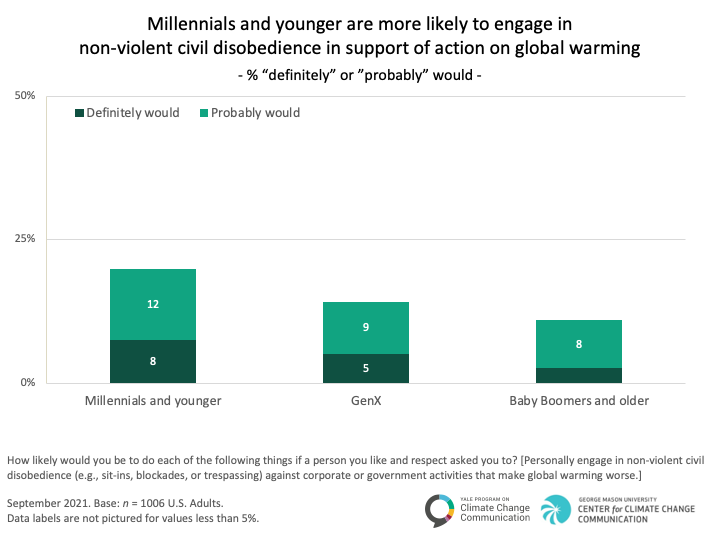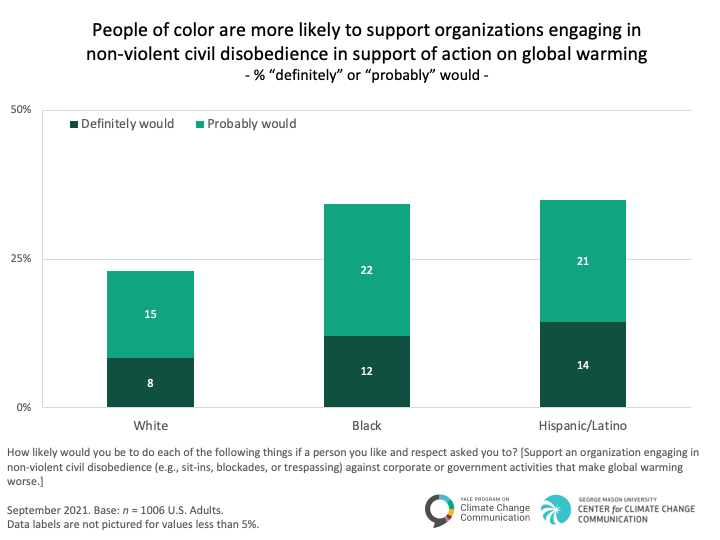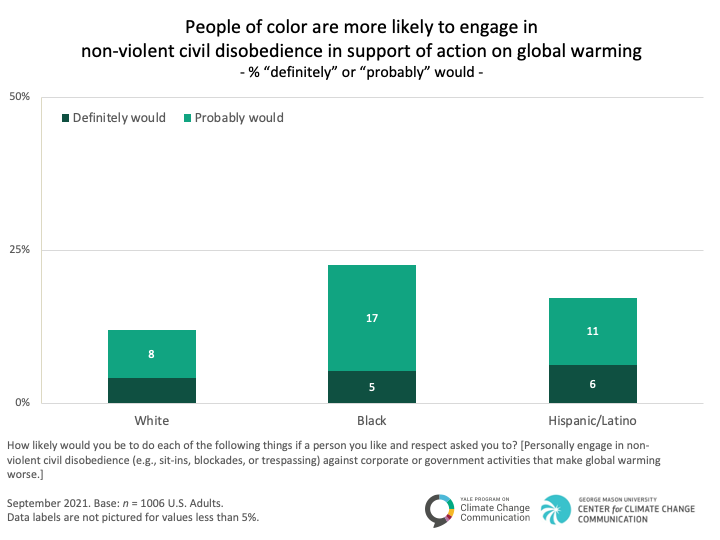By Eryn Campbell, John Kotcher, Edward Maibach, Seth Rosenthal and Anthony Leiserowitz
Editor’s Note: Erica Chenoweth has shown that there has never been an attempted regime change effort that has failed after it engaged (not just commanded the support of) 3.5% of the population. If she is correct, then this study suggests that the US population could be very close to being able to jump that bar, if it were sufficiently organized and inspired. 3.5% of the US population is about 11.5 million people. – Ed.
Social movements (e.g., anti-war, civil rights, labor, environmental) and leaders (e.g., the Reverend Dr. Martin Luther King Jr., Mahatma Gandhi, Rosa Parks) have historically used non-violent civil disobedience (e.g., sit-ins, blockades) as a powerful tool to build political power and motivate corporate or government action. In recent years, groups like Extinction Rebellion have advocated for the use of non-violent civil disobedience to promote climate action.
In September 2021, we asked Americans about their willingness to support an organization engaging in non-violent civil disobedience against corporate or government activities that make global warming worse and about their willingness to personally engage in such non-violent civil disobedience themselves. Here we examine how this willingness varies across different groups including Global Warming’s Six Americas, generations, and the three largest racial/ethnic groups in the United States.
Among the Six Americas segments, the Alarmed are the most likely to support an organization engaging in non-violent civil disobedience; half (50%) said they “definitely†(21%) or “probably†(29%) would support such an organization.

Likewise, about one fourth (28%) of the Alarmed said they “definitely†(10%) or “probably†(18%) would personally engage in non-violent civil disobedience against corporate or government activities that make global warming worse, if asked to by a person they liked and respected. The ten percent of the Alarmed who are “definitely willing†to personally engage in non-violent civil disobedience represents approximately 8.6 million American adults.

We then examined three age categories – Millennial and younger adults (aged 18-40), Generation X (aged 41-56), and Baby Boomers and older (aged 57+). Millennial and younger adults are more likely to support organizations engaging in non-violent civil disobedience than older generations, with about one third (35%) stating they “definitely would†(14%) or “probably would†(21%) support them.

Millennial and younger adults are also more likely than Baby Boomers or older to say they would personally engage in non-violent civil disobedience to protect the climate; 8% said they “definitely would†and 12% said they “probably would,†if asked to by a person they liked and respected.

People of color are more likely than whites to support organizations engaging in non-violent civil disobedience. About one third (34%) of Black Americans “definitely would†(12%) or “probably would†(22%), and about one third (35%) of Hispanics/Latinos “definitely would†(14%) or “probably would†(21%) support such organizations.

People of color are also more likely than whites to say they would personally engage in non-violent civil disobedience in defense of the climate; about one in six Hispanics/Latinos (6% “definitely would†and 11% “probably wouldâ€) and one in five Black Americans (5% “definitely would†and 17% “probably wouldâ€) say they would engage in such actions, if asked to by a person they liked and respected.

In summary, we find that members of the Alarmed, younger people, and people of color are more likely to support organizations or personally engage in non-violent civil disobedience. We also find that more people support organizations engaging in non-violent civil disobedience than are willing to take such actions themselves, likely due to barriers such as fear of arrest. Nonetheless, this analysis indicates that there are millions of Americans willing to support organizations and personally participate in non-violent civil disobedience against corporate or government activities that make global warming worse.
Methods
These data were produced from the Climate Change in the American Mind survey, a nationally-representative survey of public opinion on climate change in the United States conducted by the Yale Program on Climate Change Communication and the George Mason University Center for Climate Change Communication. Surveys were conducted from October 2008 to September 2021 using the Ipsos KnowledgePanel®, a representative online panel of U.S. adults (18+). All questionnaires were self-administered by respondents in a web-based environment.
Average margin of error for each wave: +/- 3 percentage points at the 95% confidence level. Percentage values are weighted to align with U.S. Census parameters. For tabulation purposes, percentage points are rounded to the nearest whole number. Additionally, summed categories (e.g., “definitely would†+ “probably wouldâ€) are rounded after sums are calculated.
By-lines for Eryn Campbell, John Kotcher, Edward Maibach, Seth Rosenthal and Anthony Leiserowitz: Click on the link below to be taken to this article and links to by-lines for each contributor.
This article was published on January 25, 2022, at Yale Program on Climate Change Communication.
